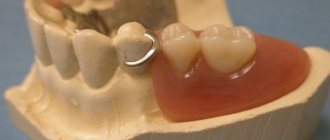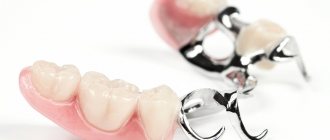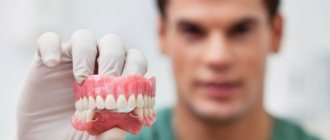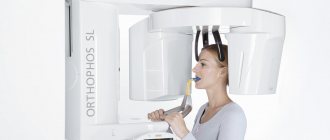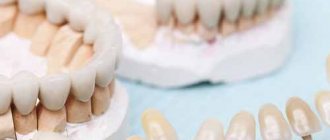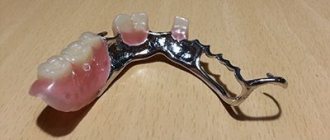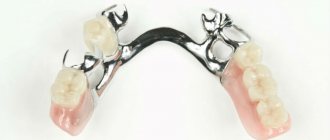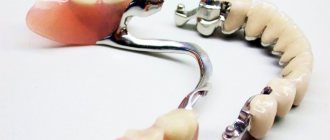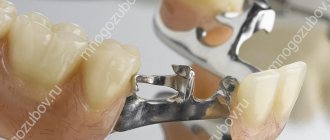Home → Articles → Technique for making a clasp prosthesis
Clasp denture is a removable device that compensates for partial tooth loss. Its main distinguishing feature is the presence of an arched metal frame. Due to the original design, the use of the device is characterized by convenience.
The technique of clasp prosthetics is a painstaking process that takes a lot of time. It consists of two stages: clinical, laboratory. Each device is created in a dental clinic according to personal casts of the jaws.
Sign up for a consultation at the dental clinic “Stomatolog11” in the Northern Administrative District:
Make an appointment
What is a clasp?
The clasp is a titanium, chromium-cobalt or gold-platinum frame in the shape of an arc with special fasteners. The main advantage of such dentures is their ability to rest not only on the gums, but also on the body of the jaw, palate, alveolar processes and healthy teeth.
Thanks to this design, the chewing load and pressure are evenly distributed over the entire dentition, preventing the process of loosening and premature loss of healthy teeth.
Nowadays, clasp prosthetics is becoming more and more in demand and popular.
This is due to a noticeable qualitative leap in the production of prosthetics. Modern clasps have a lightweight, durable, openwork design and practical fastenings that are invisible to prying eyes; they are durable, reliable and easy to use.
NeoStom – Dentistry website
Currently prosthetics with clasp dentures is becoming increasingly popular. This is due to a sharp qualitative leap in their production, due to the creation of new materials that make the design of the clasp prosthesis light, openwork, and, in many cases, invisible to prying eyes. Such prostheses are comfortable, hygienic, and patients use them with pleasure. A supported prosthesis of any type consists of the main components: 1) plastic base with artificial teeth; 2) fastening systems: support-retaining clasps, telescopic crowns, locking fastenings, beam fastenings, metal frames - for clasp dentures. CHARACTERISTICS OF PARTIAL REMOVABLE BUGEL DENTURES Clasp dentures - a type of removable dentures. The basis of the clasp prosthesis is a solid metal frame. In the case of the absence of a large number of teeth, when it is not possible to make bridges, and implantation is unacceptable for various reasons, a clasp prosthesis is the optimal choice.The chewing load in the presence of a denture in the mouth is distributed partly to the remaining teeth, and partly to the gums in the area of missing teeth. With the help of a clasp denture, it becomes possible to evenly redistribute the chewing load. Clasp denture is one of the most frequently recommended removable structures for severe disorders of chewing function. Advantages and disadvantages of clasp dentures. Clasp removable dentures have a number of advantages over fixed dentures. 1. Clasp dentures, like plate dentures, in most cases do not require preparation (grinding) of teeth and subsequent production of crowns on the supporting teeth, therefore they are less traumatic for the hard tissues of the teeth, pulp and periodontium. 2. The removable principle makes it possible to easily remove the prosthesis for hygienic care. The materials used to make such dentures can be easily cleaned with ordinary tap water, and your own teeth can be easily cleaned with a toothbrush and paste. Such effectiveness of hygienic care for the oral cavity and dentures is impossible with fixed prosthetics, because Between the gums and artificial teeth, niches are formed in which food debris accumulates, tartar is deposited, and microflora develops abundantly. 3. A large assortment of artificial teeth makes it possible to produce removable dentures that exactly match the color, shape and size of natural teeth. In addition, artificial teeth in factory-made removable dentures are obviously stronger than laboratory-made artificial teeth in fixed dentures. The disadvantage of fixed bridges is that the clasp prosthesis is a removable structure, and this always (especially at first) causes some inconvenience to the patient.
Based on the above arguments in favor of removable clasp dentures, one should not conclude that in any case preference is given to removable dentures. It must be taken into account that there are clinical situations in the oral cavity when fixed prosthetics cannot be implemented. In these cases, removable prosthetics comes to the rescue. Removable dentures, unlike fixed ones, are used for any topography and size of the dentition defect, because they evenly distribute the chewing load on most of the remaining teeth, as well as on the gum mucosa and underlying bone tissue. This ensures that the patient’s own teeth will not be overloaded and will last as long as possible. It is known that the choice of removable denture design depends on many factors, including the type and location of the defect. The larger the area of a removable denture, the less pressure it exerts on the underlying tissues, therefore, the larger the defect in the dentition, the larger the base surface should be. However, the plastic base covering the palate, being a foreign body, can cause a number of unpleasant sensations and side effects, to eliminate which, when making removable dentures, the smallest possible base area is chosen. Clasp dentures are radically different from removable plate dentures. The only thing they have in common is that they can be taken off and put on. The word "Bugel" means "arc" in German. Instead of a massive plastic base that covers almost the entire jaw, clasp dentures have a thin openwork casting, and support-retaining clasps very well fix the prosthesis both by specially prepared (clasp) crowns and simply by natural teeth. Clasp dentures are comfortable and elegant, do not interfere with conversation, do not interfere with diction and do not affect the appearance of an undesirable accent.
For clasp dentures, it is necessary to have several stable supporting teeth on which the clasps will be fixed. This allows you to get rid of the massive base, which is designed to perform supporting and suction functions. Teeth intended for supports must be selected very carefully so as not to overload them during operation, otherwise the support-retaining apparatus may be damaged, and subsequently the teeth may become loose and fall out. Consequently, the big advantage of a clasp prosthesis is that its base is metal (solid), due to which its strength is tens of times higher, and its dimensions are optimally minimal. Clasp dentures have a number of advantages compared to lamellar removable dentures: 1. It is known that conventional lamellar dentures often break, after repair they no longer fit accurately to the tissues of the prosthetic bed and cause pain. Clasp dentures are more durable because They have a lightweight metal frame made of chromium-cobalt alloys that are safe for the body. 2. Clasp dentures take up significantly less space in the mouth and cause virtually no inconvenience when talking and eating. The patient gets used to such a prosthesis more easily and quickly and feels comfortable. 3. When chewing, the load is transferred not only to the gums and mucous membranes, as with prosthetics with removable plate dentures, but is distributed over the entire jaw, including the remaining teeth. Due to less stress on the gums, chewing is more efficient and pain-free. 4. Removable laminar dentures cover the palate and often cause a gag reflex, prosthetic stomatitis, and changes in diction in the patient. The clasp prosthesis leaves the entire palate free and does not cause discomfort. STRUCTURAL ELEMENTS OF A BUGEL PROSTHESIS
The clasp prosthesis consists of: 1) a metal frame, which includes an arch (clasp) and fixing elements; 2) base (bases) or saddle-shaped part with artificial gums, on which artificial teeth are located. The frame of the clasp prosthesis consists of connecting elements (arch and its branches), fixing and supporting elements (clasps, locking and telescopic connections, beam fastenings), stabilizing elements (continuous clasp, clasps) and unloading elements (shock absorbers and load crushers). The set of structural elements of a partial removable denture is determined, first of all, by its general design, which, in turn, is planned by the doctor depending on the clinical picture of partial tooth loss, the type and topography of dentition defects, the number and condition of the remaining teeth and the mucous membrane of the prosthetic bed. Supporting elements are introduced into the design of a partial removable denture to create the most rational way of transmitting chewing pressure to the tissues of the prosthetic bed - periodontal-gingival. In addition, the supporting elements contribute to better fixation of the partial removable denture. These include, first of all, various types of occlusal overlays, artificial crowns, bridges, root inlays, root pins or implants. Connecting (fixing) elements . These elements are designed to fix the prosthesis on the remaining teeth, i.e. they act as a connector between the removable denture and the supporting teeth. For this reason, some authors call them anchors or anchor elements. According to the method of transmitting chewing pressure to the supporting teeth, connecting elements are divided into rigid, movable (hinged), and semi-movable (spring). Structurally, the connecting elements can be divided into clasps, anchor connections, beam structures, locking fastenings and double (telescopic) crowns.
The connecting elements will be discussed in more detail in the section “Methods of fixing clasp dentures.” Leveling elements. The leveling elements include, first of all, the base of a partial removable denture (plastic or metal), which connects its saddle parts, the lingual or vestibular arches of clasp dentures, which also connects its saddle parts. The latter, as leveling elements, are considered the most effective. Lingual or vestibular arches contribute to a more uniform (leveling) distribution of the functional load between the saddle-shaped parts of the prosthesis due to their elastic properties, which contributes to their better stabilization and preservation of the tissues of the prosthetic bed. Moreover, their dimensions and position must be determined in accordance with their ability to withstand functional loads. The leveling elements are also subject to fairly strict phonetic and hygienic requirements. At the same time, it should be borne in mind that the leveling elements can, along with their connecting function, also serve as elements to counteract the shift of the prosthesis. However, from a functional point of view, it is very difficult to make a strict division here. Elements to counteract prosthesis shifting . Under the influence of functional load developing in the horizontal plane, the partial removable denture is subject to displacement in the anteroposterior or lateral directions. The elements to counteract this displacement (primary) are, first of all, various types of fixing elements (clasps, locking fastenings, beam fixation systems, etc.). In case of periodontal diseases, elements to counteract the shift of the prosthesis include Elbrecht splints, claw-shaped processes of continuous clasps, a combination of Ney clasps and Elbrecht splints, etc.
Artificial crowns and bridges can indirectly, through the clasp, counteract the shift of the prosthesis. They are sometimes referred to in foreign literature as secondary elements to counteract the shift. When using elements of this group, special attention should be paid, along with other clinical data, to the periodontal condition of the remaining teeth. Elements to prevent the prosthesis from tipping over. Most of the fixing (connecting) elements of the prosthesis, due to their guide planes, have the function of counteracting tipping, i.e. forces that remove the denture during mastication. The anti-tip element must be located outside the axis of rotation of the prosthesis in the opposite direction from its saddle parts, i.e. main part of the prosthesis. This effect is achieved by occlusal pads located on the periphery of the clasps or by a reverse-acting cast clasp located away from the saddle-shaped part of the prosthesis. The arch connects the saddle-shaped parts of the clasp denture and distributes chewing pressure on the supporting teeth and the alveolar process. The arch combines the parts of the prosthesis into a single whole. Due to the elasticity of the alloy, it helps reduce the load on the saddle-shaped parts of the prosthesis. The size and position of the arch depend on the jaw on which it is located, the type and location of defects in the dentition, the shape and depth of the palatal vault, the shape of the slope of the alveolar part (process), and the condition of the mucous membrane of the prosthetic bed. The arch should follow the configuration of the hard palate or alveolar part of the jaw. The base (saddle-shaped part) is a part of the clasp prosthesis that carries artificial teeth and replaces part of the alveolar process. The dimensions of the basis depend on the size and topography of the defect. With included defects, the bases are small, with terminal defects they completely cover the alveolar process with maxillary tubercles on the upper jaw, and retromolar tubercles on the lower jaw.
Manufacturing technology of a clasp prosthesis In total, the process of manufacturing a solid-cast clasp prosthesis consists of the following stages: 1) preparing the oral cavity for prosthetics; 2) diagnosis and choice of prosthesis design; 3) study of diagnostic models; 4) obtaining casts and working models from supergypsum; 5) determination of central occlusion; 6) studying the working model in a parallelometer; 7) marking the frame of the clasp prosthesis on a plaster model; duplicating the model using hydrocolloid mass; 9) obtaining a fire-resistant model; 11) reproduction of the frame pattern of the clasp prosthesis on a fire-resistant model; 12) modeling of the frame of the clasp prosthesis; 13) creation of a gating system and casting process; 14) finishing the frame of the clasp prosthesis; 15) checking the frame of the clasp denture in the oral cavity; 16) modeling of wax bases and placement of artificial teeth; 17) replacement of wax bases with plastic; 18) finishing and polishing of the clasp prosthesis; 19) application of a clasp prosthesis to the jaw. OBTAINING IMPRESSIONS AND MODELS To correctly select the design of a partial removable clasp denture, it is necessary to initially obtain diagnostic models. On diagnostic models you can see what is impossible to notice in the oral cavity when the teeth are closed: the ratio of the lingual and palatal cusps, the severity of secondary deformations of the dentition, blocking points during various movements of the lower jaw, the amount of incisal overlap and, finally, the availability of space for the occlusal parts of the clasp or transfer elements. If there is no space on the models, areas to be sanded are marked. If you do not create space for the occlusal elements of the support-retaining clasp, then the latter will either violate the occlusion of the dentition or will be too thin, which will lead to their rapid breakage.
2) diagnosis and choice of prosthesis design; 3) study of diagnostic models; 4) obtaining casts and working models from supergypsum; 5) determination of central occlusion; 6) studying the working model in a parallelometer; 7) marking the frame of the clasp prosthesis on a plaster model; duplicating the model using hydrocolloid mass; 9) obtaining a fire-resistant model; 11) reproduction of the frame pattern of the clasp prosthesis on a fire-resistant model; 12) modeling of the frame of the clasp prosthesis; 13) creation of a gating system and casting process; 14) finishing the frame of the clasp prosthesis; 15) checking the frame of the clasp denture in the oral cavity; 16) modeling of wax bases and placement of artificial teeth; 17) replacement of wax bases with plastic; 18) finishing and polishing of the clasp prosthesis; 19) application of a clasp prosthesis to the jaw. OBTAINING IMPRESSIONS AND MODELS To correctly select the design of a partial removable clasp denture, it is necessary to initially obtain diagnostic models. On diagnostic models you can see what is impossible to notice in the oral cavity when the teeth are closed: the ratio of the lingual and palatal cusps, the severity of secondary deformations of the dentition, blocking points during various movements of the lower jaw, the amount of incisal overlap and, finally, the availability of space for the occlusal parts of the clasp or transfer elements. If there is no space on the models, areas to be sanded are marked. If you do not create space for the occlusal elements of the support-retaining clasp, then the latter will either violate the occlusion of the dentition or will be too thin, which will lead to their rapid breakage.
Grinding of areas of the occlusal surfaces of teeth. It is advisable to start grinding from the cusps of antagonist teeth that are in contact with the area where the occlusal pads or switching element will be located. The amount of grinding is controlled by occlusal movements of the lower jaw. It is also permissible to deepen the natural fissures of the teeth, where occlusal linings are supposed to be placed, as well as grinding the zone of transition of the chewing surface to the proximal one to place the reversible elements of the support-retaining clasps. Grinded areas of hard dental tissues must be thoroughly polished using a rubber wheel using soft polishing pastes and fluoride varnish. After grinding the teeth, casts and working models are made from superplaster. Obtaining an impression. Taking impressions in the manufacture of clasp dentures is mainly carried out according to generally accepted methods. It is necessary to carefully select the impression material and the dimensions of the impression tray. The choice of impression material is influenced by the condition of the mucous membrane of the prosthetic bed. The initial plaster model is important for obtaining accurate casting of the clasp prosthesis frame. Therefore, special requirements are placed on casts. Currently, to obtain impressions, mainly elastic alginate impression materials (stomalgin, elastic, etc.) are used, which make it possible to obtain an accurate image of the chewing surface, the equator of the tooth, undercuts and interdental spaces, since these areas are the location of the clasp elements. It should be noted that when taking plaster casts, in order to avoid distortion of the shape of the crown of the supporting teeth when removing the cast from the oral cavity, incisions should not be made above the supporting teeth. Usually, when making prosthetics for patients with partial loss of teeth, an anatomical impression is taken with a standard impression tray. Meanwhile, the clinical anatomy for some defects of the dentition is so complex that it can be difficult and sometimes impossible to ensure the success of prosthetics (in particular, with terminal defects of the dentition, significant atrophy of the alveolar part, and even the body of the lower jaw) using an anatomical cast. Therefore, in some cases, they resort to taking a functional impression with individual impression trays, which is considered mandatory when making prosthetics for patients with complete absence of teeth. An individual spoon is made according to a diagnostic model obtained in the traditional way.
To make the frame of a clasp prosthesis, two working casts and one auxiliary cast are taken on a fire-resistant model. If clasp dentures are made for both jaws, then four impressions are obtained (two from each jaw). This is necessary in order to use one model for studying it in a parallelometer with subsequent duplication, and the second for making wax bases with occlusal ridges, determining the central occlusion, plastering into the occluder and the final production of the clasp prosthesis. Casting models. The quality of the working model is of great importance, which the doctor must constantly monitor at all clinical stages: when determining central occlusion, checking the design of a removable denture. To make a clasp denture, it is important to have durable, abrasion-resistant jaw models. In such models, parts exposed to load, pressure, and friction (mainly supporting teeth) are made of supergypsum, fusible metal, dental cement, amalgam, and the rest are made of ordinary medical plaster. To improve the quality of the model’s plaster, it is better to cast it on a special vibrating table, in which case the plaster is compacted and air bubbles are released. The model must be properly processed, have a smooth surface without pores, and be well dried. In order for the occlusal surface to be parallel to its base, it is necessary that the bottom of the tray be parallel to the surface of the table on which the casting is made. In this case, the bottom of the tray is like a plane of the occlusal surface of the teeth. The height of the base of the model (base) must be at least 2 cm. If defects in the working model are identified, work should be suspended and the cast should be retaken. The method for determining central occlusion and the central relationship of the jaws does not differ from that described in the section “Partial removable plate dentures”.
You might be interested in:
- Anchor fixation system
- Types of clasps
- Ney system clasp
- Clasp structure
- Planning the design of a clasp prosthesis
Structure and types of clasp dentures
A standard clasp prosthesis consists of a durable frame equipped with supporting, retaining and unloading elements:
- arc;
- fastenings;
- base with artificial plastic or porcelain teeth.
Depending on the type of fastenings, the following types of clasp dentures are distinguished:
- clasp (the device is held in the mouth thanks to special hooks that tightly cover the supporting teeth);
- locking (prostheses are attached to metal-ceramic crowns placed on abutment teeth);
- with a telescopic fixation system (to secure the prosthesis, two interlocking crowns are used, one of them is located on the device itself, and the second is attached to the abutment tooth).
Clasp
Castle
Service life and how to care
On average, the service life of a clasp prosthesis is 2–3 times longer than that of a conventional plate prosthesis. This is achieved through more advanced production technology and high-quality raw materials.
With good care - daily at home and regular professional hygienic cleaning in dentistry - your new teeth will last from 5 to 7 years. On implants – up to 10 years due to the absence of resorption, play and displacement during chewing.
Caring for clasp dentures
Every day, twice a day at least, and ideally after every meal, you need to brush your teeth. If the denture is removable, remove it and wash it with soap or toothpaste, thoroughly cleaning the surfaces with a brush. Rinse with boiled or purified water.
Once a day, disinfection should be carried out by dipping the prosthesis in a disinfectant solution for 5–10 minutes. For its preparation, special water-soluble tablets are used. Once a week you can soak it for a longer period in a bio-solution for better cleaning.
Using this method, all biological debris, including pieces of food and plaque, are removed from the prosthetic surface. After disinfection, the product is washed with boiled water and is ready for storage in a case or use. Dentists strongly do not recommend leaving the prosthesis in storage for a long time, especially if it has a splinting effect.
You should make an appointment for professional cleaning at least twice a year. In this case, the denture workshop cleans the polymer and metal parts, as well as calibrates them to fit the patient’s jaw.
Careful care, timely repairs and relining extend the life of the product, allowing you to avoid its breakage due to the gingival contour changing over time and the associated improper load distribution.
Stages of clasp prosthetics
Preparation of prosthetics
Preparation for clasp prosthetics begins with an examination of the patient. Doctors carefully listen to the patient’s complaints and wishes, conduct a dental examination, and study the patient’s medical history. After this, after analyzing the results of the examination, dentists decide on the need for clasp prosthetics.
Treatment of dental diseases
Before the production of the prosthesis begins, teeth that cannot be preserved are removed, periodontal disease and other dental diseases are treated. If there is a pronounced inclination of the abutment tooth or if there are restorations on it, as well as with prosthetics using telescopic or locking fixation, crowns are put on the abutment teeth.
Price
The price of clasp prosthetics depends on the degree of complexity of the clinical case - the number of defects, their location, selected materials and manufacturing technology. Prices for prosthetics start from 50 thousand rubles.
The final cost of treatment is also influenced by the preparation and depulpation of supporting teeth for a crown, concomitant treatment of caries, gum and periodontal diseases, and bleaching for the optimal choice of shade of polymers.
You can find out how much a clasp prosthesis will cost in your particular case and ask any questions you have by consulting with an orthopedist in our clinic. Call to make an appointment at a time convenient for you. We'll be happy to help!
Making a prosthesis
All video presentations
Taking an impression
The production of a clasp prosthesis begins with taking a diagnostic impression. This impression is used to create a working model, which the dental technician is guided by when making the frame.
Production of clasps
The most critical stage of work is the production of clasps or crowns with fasteners. The clasps must accurately follow the shape of the patient’s supporting teeth and tightly cover them without damaging the enamel. In turn, the crowns with the mating parts of the locks must completely correspond to the clasp itself with the lock. Precision in the production of fasteners is a guarantee of the durability of the prosthesis and ease of use.
Casting the prosthesis frame
Having completed work on the manufacture of fasteners, the dental technician sketches the frame of the prosthesis and duplicates the working cast, that is, creates a fire-resistant master model. Then the sketch of the future clasp is transferred to a fireproof cast, and casting channels and a flask are installed on it. Gold-platinum, titanium or cobalt-chromium alloys are used to cast the frame.
Installation of artificial teeth and fitting
The finished frame is polished, support-retaining and unloading elements are attached to it, and it is tried on in the patient’s growth cavity. After this, artificial teeth matching the color are installed on the base and re-fitting is performed. On average, the production of a prosthesis takes 2 months.
Special clasp-type prosthetic structures
Clasp prosthesis Quadrotti
Produced using the unique patented Quattro Ti technology since 1986. The prosthesis is based on a thermopolymer (nylon-based plastic). There is no metal. Thanks to this, the prosthesis has many advantages:
- hypoallergenic;
- highest aesthetics;
- chemical inertness;
- short adaptation period;
- complete biocompatibility;
- no gum irritation;
- installation without tooth preparation.
Attention. Due to the flexibility of the design, its significant advantage is that it can be used by those who engage in boxing, wrestling and other traumatic sports, as well as those who work in harmful and dangerous industries.
Comfort of wearing is ensured by high adhesion to the surface of the prosthetic bed, elastic material, and soft clasps. Due to the lack of possibility of relining, such prostheses must be changed once every 3–3.5 years.
Quattro Ti manufacturing features
The Quadrotti prosthesis is made in a dental laboratory individually for each patient using the thermocasting method. For these purposes, special equipment and raw materials are used, from which the future prosthesis is formed based on the impression and model of the jaw.
The manufacturing technology is worked out to the smallest detail, so butterfly prostheses and larger thermoplastic structures wear well. Their invisibility on the teeth is ensured by the presence of several shades of raw materials.
White plastic is used inside and for hooks (clasps), and red plastic is used to make the gingival part. It practically blends with the color of the oral mucosa, so the structure on the teeth is not only not felt, but also invisible.
Care for Quattro Ti prostheses should be more gentle. They need to be cleaned with a soft brush and a special paste designed for elastic plastics. Periodic disinfection with a special disinfectant solution is recommended. For details, please contact your dentist at our clinic.
Splinting clasp dentures
In case of increased instability of the supporting teeth and the presence of a defect in the dentition, it is recommended to install dentures, the design of which contains special elements (processes, clasps). With their help, the prosthesis tightly covers the crowns of the teeth, which avoids further loosening.
The indication for wearing a splinting prosthesis is not only degree II-III tooth mobility, but also a pathological deep bite along with increased abrasion of the tooth surface.
Its distinctive feature is the presence of individual hooks on the teeth or an entire arch running along the inner surface of the dentition.
The advantage of this design is the uniform distribution of the load throughout the jaw, rather than concentrating it on just the supporting teeth. It is also worth additionally noting such an important plus as light weight.
Advantages and disadvantages of using clasp dentures
Benefits of prosthetics
The main advantages and advantages of clasp prosthetics are:
- durability, reliability and strength of prostheses;
- tenacity of fastening the clasp in the oral cavity;
- the ability to perform prosthetics even if there are only a few teeth in the dentition;
- ease of care for the prosthesis;
- the ability not to remove the clasp at night;
- no discomfort, impaired diction, or inconvenience when eating.
Read also
Removable dentures: which ones are better?
Dental restoration using removable dentures can be an alternative to fixed structures.
What to do after tooth extraction: recommendations
Tooth extraction is an invasive dental procedure that requires a recovery period.
Purpose of structures
The color and shape of clasp products meet high aesthetic requirements. They help eliminate lingering defects in various parts of the jaw row.
The prosthesis, equipped with locks and attachments, has a one-piece frame with an acrylic base. This design makes it possible to achieve high strength values of the base, so there is no need to create a massive base, which means that the frame and artificial gum will be light in weight.
This makes clasp prosthetics optimal for a patient with partial edentia.
A removable orthopedic device is used as a more advanced alternative to partial plate prosthetics in cases where, due to a complex clinical picture, it is impossible to produce a permanent dental bridge.
Clasp systems are prescribed in a number of clinical cases:
- double-sided end defect (there are no posterior specimens that could become a support for the bridge);
- terminal flaw on one side of the dentition;
- absence of more than 4 copies in the anterior section;
- absence of more than 3 units in the posterior part of the chewing row;
- diseases of the periodontal tissues in combination with problems with the integrity of the dentition;
- multiple pathological changes in the jaw rows;
- severe loose teeth.
General overview
Clasp denture is one of the types of removable orthodontic structures. This is a very light, elegant, reliable and comfortable device to wear that does not distort diction.
All models of clasps are technically complex. They are based on a durable metal frame, a saddle-shaped acrylic base, artificial units and fastening devices.
All parts of the device are connected to each other by an arc. It also performs a fixing function. The frame itself can be made in two versions - solid cast or soldered. The second one is much easier to produce, cheaper, but not so convenient to use.
An important condition for the installation of these products is the presence in the mouth of several fairly stable and strong teeth. It is these units that will hold the removable structure.
The degree of sensitivity of the tissues and mucous membranes of the gums, the condition of the periodontium, and the size and shape of the alveoli are also of great importance.
Technologies
Such a complex apparatus as a clasp denture is manufactured exclusively in dental laboratories. In this process, specialists use various techniques:
- Casting procedure involving removing a wax model from a workpiece. This technological process involves removing the wax product from a plaster model and placing it in unmolded refractories. The fat-like solid is then removed and the model is filled with molten metal.
- Casting process in the fabrication of a system using a fireproof model .
This technique differs mainly from the first method. It does not involve shrinkage of the metal alloy and eliminates any transformation of the wax preliminary product during its removal from the model and placement in unmolded refractories.
For the laboratory stages of manufacturing the apparatus on a fireproof model, it will be necessary to take impressions. An important role in the process of casting the frame of the product is played by the primary plaster model.
In the case of a fireproof model, two impressions will be required. One will be used in the workflow, the second as an additional element.
If products are made for both jaws, the output should be four models - a pair for each jaw structure.
That is, one prosthesis will be used as a fitting with subsequent production of its copy, and the second will serve as the basis for performing the base with rollers, checking the bite, plastering process and final work on the manufacture of the product.
Material used
The main material for the manufacture of the arch of clasp prosthetic structures is chromium-cobalt alloy. The arc of fastening of prosthetic structures with locks includes metal-ceramic crowns. A more expensive, and therefore less common, option is to use gold-platinum alloy instead of chromium-cobalt alloy, which does not cause allergies. In addition, there are metal-free clasp dentures, which use ceramics or extremely durable pressed plastic to make the arch. They are intended for patients suffering from metal allergies. These dentures are more fragile than metal ones, so they are at greater risk of damage and have a shorter lifespan.
Price
The cost of clasp structures is high in comparison with other removable products. But, despite this fact, their use today is one of the most popular services in dental clinics.
This table provides information on the average cost of various clasp systems. These figures already include payment for oral cavity preparation services.
| Type of prosthesis | Price, thousand rubles |
| Simple for one jaw | from 15 |
| System for 2 jaws | about 25 |
| Splint system | from 20 |
| Micro-lock design | about 40 |
| Product on telescopes | about 70 |
The figures given are subject to change. Their upward fluctuation depends on the complexity of the design itself, the type of material used in production, and the type of fastening used.
Advantages and disadvantages
This type of prosthesis has many advantages, including:
- Uniform distribution of chewing load. There is no discomfort during use and the gums are not injured.
- Compactness. This quality distinguishes this type of construction from acrylic dentures. Getting used to it happens quite quickly.
- Easy to care for.
- Minimal effect on diction, as well as no effect on taste.
- Reliable fixation.
- Reasonable price compared to other types of removable prosthetics.
Minuses:
- Low aesthetics . The clasp system for fixing clasp dentures provides high reliability of fastening, but not beauty. Hooks can sometimes be noticeable when speaking.
- The need for regular hygienic treatment of the prosthesis. It needs to be brushed and rinsed, just like natural teeth, so this disadvantage is not so great.
Reviews
The presented type of prosthetics, although considered partly democratic, still remains inaccessible to most patients.
However, this is the best offer that dentistry can recommend today for the stated price. Prosthetics with clasp products are reliable, safe and durable.
You can leave your feedback on the prosthetic technique in the comments to this article.
If you find an error, please select a piece of text and press Ctrl+Enter.
Tags clasp dentures removable dentures
Did you like the article? stay tuned
Previous article
What is unique about Korean Anyridge implants?
Next article
What to do if a splinter remains after tooth extraction
Indications and contraindications
Prosthetics with clasp structures are carried out in the following cases:
- absence of frontal teeth on the upper or movable jaw;
- various dental defects;
- deep incisal overlap (complex anomaly of teeth closure);
- bruxism (teeth grinding);
- dystrophic disease of the tissues surrounding the unit (periodontal disease).
There are also categorical prohibitions on installation:
- allergic reactions to metal;
- lack of support units;
- shallow depth of the bottom of the movable jaw;
- low crown part of healthy teeth;
- diabetes;
- oncology;
- disruption of the cardiovascular system;
- dental inflammatory diseases;
- respiratory diseases.
What are T Crystal dentures, the material used for manufacturing.
This publication is dedicated to Flexi Nylon prostheses.
Here https://www.vash-dentist.ru/protezirovanie/semnyie-p/silikonovyih.html all the most important things about silicone dentures.
